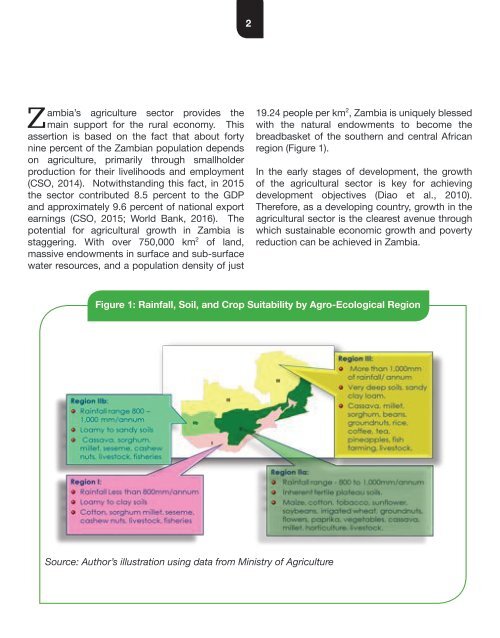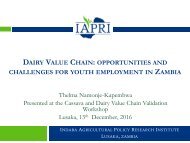ZAMBIA
IAPRI-Booklet
IAPRI-Booklet
You also want an ePaper? Increase the reach of your titles
YUMPU automatically turns print PDFs into web optimized ePapers that Google loves.
2<br />
Zambia’s agriculture sector provides the<br />
main support for the rural economy. This<br />
assertion is based on the fact that about forty<br />
nine percent of the Zambian population depends<br />
on agriculture, primarily through smallholder<br />
production for their livelihoods and employment<br />
(CSO, 2014). Notwithstanding this fact, in 2015<br />
the sector contributed 8.5 percent to the GDP<br />
and approximately 9.6 percent of national export<br />
earnings (CSO, 2015; World Bank, 2016). The<br />
potential for agricultural growth in Zambia is<br />
staggering. With over 750,000 km 2 of land,<br />
massive endowments in surface and sub-surface<br />
water resources, and a population density of just<br />
19.24 people per km 2 , Zambia is uniquely blessed<br />
with the natural endowments to become the<br />
breadbasket of the southern and central African<br />
region (Figure 1).<br />
In the early stages of development, the growth<br />
of the agricultural sector is key for achieving<br />
development objectives (Diao et al., 2010).<br />
Therefore, as a developing country, growth in the<br />
agricultural sector is the clearest avenue through<br />
which sustainable economic growth and poverty<br />
reduction can be achieved in Zambia.<br />
Figure 1: Rainfall, Soil, and Crop Suitability by Agro-Ecological Region<br />
Source: Author’s illustration using data from Ministry of Agriculture



